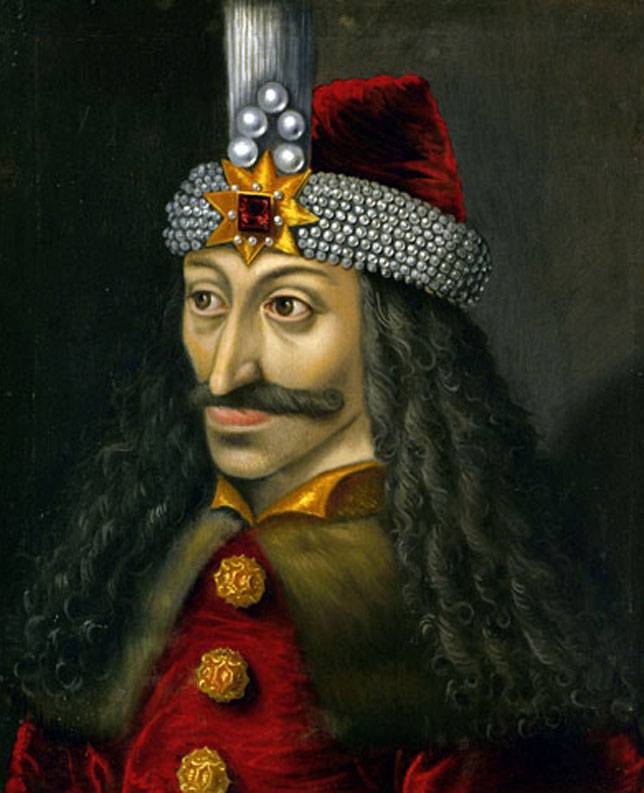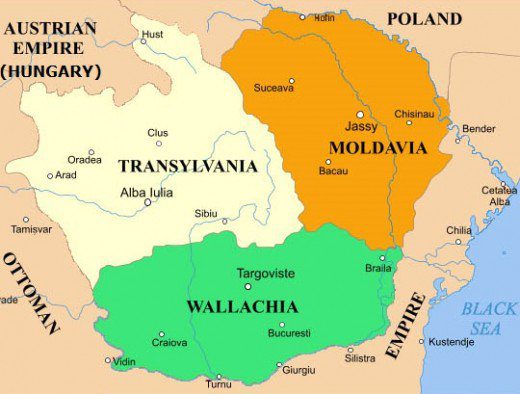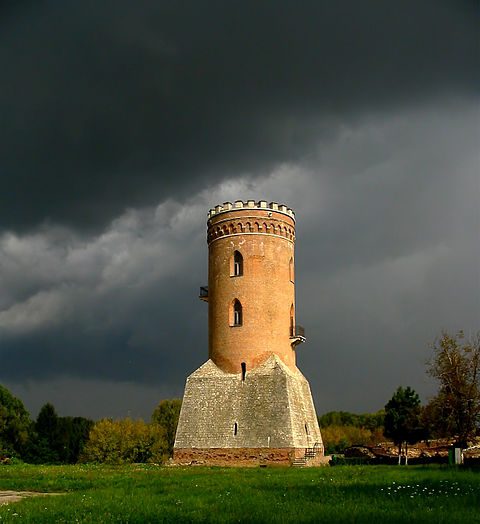
Romania’s Wooden Churches – Where History Meet Art
December 20, 2017
Where Are The Bears?
January 24, 2018By Warren Singh-Bartlett
Hero or villain? History is full of people who can be viewed as either, depending on your perspective. Take Vlad III, the Wallachian prince known in Romanian as Vlad Tepeș, or Vlad the Impaler.

A portrait of Vlad Tepes. (Image: Wikimedia Commons)
Bloody sobriquet aside, to the Romanians and the Bulgarians, Vlad III is a hero, credited for having kept the relentless Ottoman advance into Europe at bay. To his historic enemies, chiefly the Hungarians and the Saxons, he was a monster, a blood-crazed practitioner of unique forms of cruelty and torture and quite possibly the son of the Devil himself.
The truth, of course, lies somewhere in between.
Vlad III was born in Sighișoara in 1431 and was the second son of Vlad II, the Voivode (prince) of Wallachia. The Voivode was a member of the Order of the Dragon, a chivalric order of nobles set up by the Holy Roman Emperor to counter the Ottoman threat and was known as Vlad Dracul, or Vlad the Dragon. This is how Vlad III came to be known as Vlad Dracula or Vlad, son of the Dragon.
In 1442, Vlad Dracul lost his throne after a faction of Wallachian nobles allied with the Hungarians ousted him. Placing his commitment to protect Europe from the Ottomans to one side, he petitioned them for help in getting it back. Sensing an opportunity to strengthen their foothold in Europe, the Ottomans agreed. In exchange, Vlad II was required to send Vlad III and his youngest son, Radu, to the royal court as tributes. Although only a boy, he would have been roughly 12 at the time, Vlad never adapted to captivity, however golden his chains. Radu, who was much younger, fared better and eventually became an Ottoman noble.
In 1447, Vlad Dracul again lost his throne to the Wallachian nobles and together with his eldest son, Mircea, was buried alive. In order to shore up their foothold, the Ottomans permitted Vlad III to return to claim his father’s throne and the following year, he was crowned Voivode, the first of three occasions on which he would hold the title.
His first rule as Voivode ended almost as quickly as it had begun and as he fought to regain his throne, the battle pitted him against the Hungarians, the Wallachian nobles, the Saxons and then eventually, the Ottomans. Ruthless in his ambition, by the time he regained the throne in 1456, Vlad was already on his way to earning his sobriquet of Tepeș because of his penchant for impaling enemies, vertically or horizontally, on wooden stakes.
He was equally ruthless when it came to restoring order, executing thieves and criminals without remorse and crushing every potential source of dissent. But equally, Vlad sought to strength his principality, building new villages and helping local merchants by limiting competition from foreign and in particular, Transylvanian Saxon trade – Transylvania then being a Hungarian province.

A map of Wallachia (green). (Image: Spiridon Manoliu via Wikimedia Commons)
Nevertheless, horror stories abound. The dozen Saxon merchants impaled in Braşov for allying with Wallachian nobles ranged against him. The hundreds of Wallachian nobles lured to a parley only to be impaled for treason. The Ottoman peace envoys, whose turbans were nailed to their heads when they refused to remove them. According to his detractors, Vlad took pleasure from his actions and is said to have banqueted surrounded by the impaled but still dying nobles and to have bathed in or possibly even to have drunk their blood.
Many of the stories, which were inevitably written by Vlad’s enemies, are exaggerated and possibly fabricated, one incident is historical fact.
Vlad regained his throne the second time in part by allying with the Hungarians against the Ottomans, who having conquered Constantinople, had turned their full attention towards conquering the rest of Europe and consequently, were now a greater threat to regaining his throne than the Hungarians or disaffected Wallachian nobles. Never having warmed to his former captors, Vlad used the knowledge he had gained during his years at the Ottoman court to help defeat them and wasn’t afraid to resort to extreme acts to do so. In 1462, an army led by Sultan Mehmed II managed to reach the outskirts of Vlad’s capital city, Târgoviște. Expecting a siege, the Ottomans discovered the town had been abandoned and was ringed by the rotting corpses of 20,000 Ottoman captives. Terrified, Mehmed and his army fled.

Chindia Tower in Targoviste, Romania, built by Vlad Tepes, in the 15th century. (Image: Wikipedia)
Over time, the reputation of Vlad III has continued to grow. During the centuries of Ottoman occupation and suzerainty in the Balkans and Eastern Europe, he became an increasingly heroic source of inspiration. But tales of his bloodlust never abated and were further enflamed when, over time, the meaning of ‘dracul’ underwent a linguistic shift, changing from ‘dragon’ to ‘devil’, making Vlad Dracula the Son of the Devil, a name that suited his demonic reputation.
So was he a hero, who helped stymie the Ottoman conquest of Eastern Europe, or was he a bloody maniac with a penchant for cruel and unusual torture? Maybe the best answer in this case is yes. Hero and villain, Vlad Tepeș was all of the above and also so much more.





6 Comments
June 22, 1958 — an important day in Texas history, particularly in the cities of Comanche, Austin and San Antonio. It was in Comanche, Texas, where I grew up, that
efforts to set the record straight about Prince Vlad Tepes (Dracula) started and his name began to be cleared, but it has taken from that time until this. At the same time, Christopher Lee (Horror of Dracula and others) became an honorary member of my group of friends, who had also watched the above-mentioned film. Information about the real Dracula would come to me in the form of what I’ve called time-travel telepathy and spiritual communication.
Since then, I have lived mostly in Austin and San Antonio, where I have lectured and written commentaries about Dracula; sometimes it seems that the elements have cooperated with my work — I have seen Order of the Dragon red-orange skies in San Antonio early in the morning; also, the evening of the same day the revolution in Romania began (December 17, 1989) there was a fiery red sunset over Lake Austin. There have been many other related incidents that have taken place but it would take too long to name them here.
Recently, there has been a spirit of lawlessness and rebellion in this country, the kind of thing that Dracula was able to put a stop to because he had the authority to; additionally he almost singlehandedly put an end to Turkish domination in what is now Romania, and restored order from chaos. So much that has been told about Dracula has been skewed, fabricated and misrepresented — except in Texas!
One interesting fact most seem to ignore is that even during his reign impalement was not that common. Generally criminals were executed by decapitation or hanging. Impalement was reserved for turks and traitors, the later mostly being formed of corrupt nobles, now we would call them politicians.
Thank you! What a wonderful piece! While I’d love to know more and could read every fact and rumor no matter how trivial, this was concise, informative, and the exact thing I was looking for to answer my question. His name is a dark internet legend, constantly rolled out to shock with it’s trademark “it’s rumored that Dracula was based on him, the man who dined to the screams of the 20,000 men he had impaled”. I knew there had to be more known, an alternate side. Even the queen who bathed in blood wasn’t just a monster. Times were cruel and brutal then, idk that his actions would’ve made him anything other than human at a time when humanity was in short supply. Stories like Dracula Untold brought us tales of a brave and honorable man, regardless of it’s fiction. I never knew his name was actually Dracula though. It makes that both more and less confusing. Keep up your great work!
Thank you so much, Josh. Feel free to share it so more people know the truth.
Where can I find more information about Vald? As well as information about the order of the dragon?
Hi Katie! There is a book called “Vlad III Dracula: The Life and Times of the Historical Dracula” that you can find on Amazon. You can also get it as an audiobook. There is also the book called “Vlad the Impaler – In search of Dracula”. Hope this helps 🙂